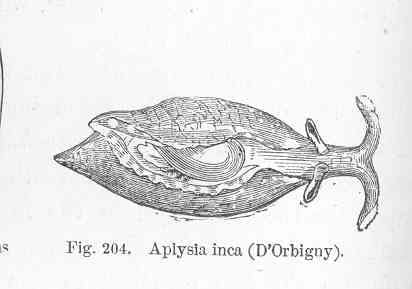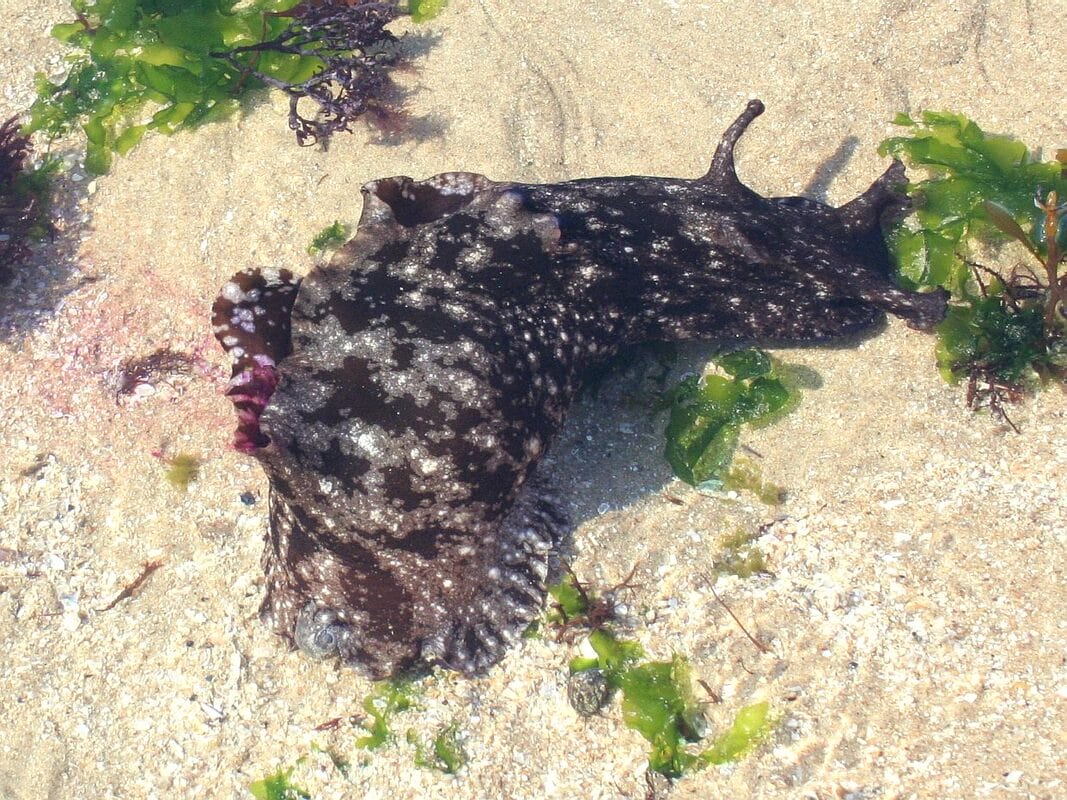Aplysia, Sea HareLepus marinusArnab bahri (Unani) |

|

|
 Ocean World : Being a Descriptive History of the Sea and its Living Inhabitants
Ocean World : Being a Descriptive History of the Sea and its Living InhabitantsFibuier, Louis (1868)
 Aplysia depilans
Aplysia depilans(Photo by Jeffdelonge) (Wikimedia)
Zoological name:
Aplysia spp.
A. depilans is most often cited, although related species are no doubt used.
Dolabella auricularia is the Wedge Sea Hare, which may have been considered synonymous.
The Sea Hares are a group of large marine slugs. They were called “Sea Hares” because their 2 protruding antenna like structures of their head looked like rabbit ears. They secrete a non-toxic reddish-purple dye when disturbed.
Parts used:
Whole animal
Temperature & Taste:
Warm, dry. Toxic
Constituents:
Brominated compounds: aplysin, aplysinol.
Aplysia species are also known to contain prostaglandins.
Uses:
1. Externally:
-its “blood” removes Freckles and Pityriasis (Avicenna)
-ground up and applied to remove hair. (Dioscorides)
-applying its burnt head promotes hair growth (Avicenna)
-applied to the eyes as a collyrium to improve vision. (Avicenna)
-used fresh for Gout and Arthritis (Salmon)
Dose:
Only used externally.
Comment:
1. Sea Hare most commonly appeared in medical texts due to the antidotes used for its poisoning. However, it did have some external uses.
2. Sea Hares have become very important in research due to their unusually large neurons.
Main Combinations:
1. Its burnt head mixed with Bear fat and applied is very effective to promote hair growth. (Avicenna)
2. As a dipilatory, apply a paste of fresh Sea Hare with Sea Anemone. (Dioscorides)
Major Formulas:
Cautions:
1. Toxic. “It is reckoned as a poisonous drug which kills by ulcerating the Lungs”. (Avicenna)
Toxicity:
1. The dye was traditionally regarded as toxic, but has been found non-toxic to humans. The animal does, however, contains toxic elements inbcluding Aplysiatoxin and Debromoaplysiatoxin, the latter of which is said to be tumor-promoting. It is also said to accumulate toxins from certain algae it eats.
2. The LD100 in mice is 0.3mg/kg.
Antidotes to Sea Hare Poison:
1. Cyclamen was taken with wine for all deadly poisons, “especially Sea Hare”. (Dioscorides)
2. One or 2 drams of Water Plantain root taken with wine. (Dioscorides)
3. Cedar taken in Raisin wine. (Dioscorides)
4. Black Hellebore with Asses Milk. (Salmon)
5. Crabs, boiled and eaten and their soup drunk is good for those who have eaten Sea Hare. (Dioscorides)
6. Woman’s Milk is an antidote to Sea Hare. (Dioscorides)
7. Roasted Fox meat eaten. (De venenis, Petrus, 1487)
Main Preparations used:
Nothing at Present
Unless otherwise stated, the following research is from Bioactive Marine Natural Products, Bhakuni & Rawat, 2005:
ANTI BACTERIAL
-aerothionin from Aplysia aerophoba showed antibacterial activity.
ANTI-VIRAL
-Two known anti-viral compounds were isolated from a Japanese species of Aplysia.
ANTI-CANCER
-Peptides from the related Dolabella auricularia showed anti-cancer activity.
-Dolabella auricularia contains Dolastatins which are potent cell growth inhibitors of lymphocytic leukemia cell line. “Dolastatin-10, which contained a number of unusual amino acids including a modified proline and O-methylisostatine, was claimed be the most potent antineoplastic agent known”.
-“Aplysistatin is a well known antileukemic metabolite from the sea-hare Aplysia angasi”.
-“The metabolites of Aplysia dactylomela are reported to have cytotoxic and antitumor activity in vivo”.
HYPOGLYCEMIC:
-Aplysia benedicti showed hypoglycaemic activity
BENODIAZEPINE
-Aplysepine, a 1,4-benzo-diazepine alkaloid was isolated from the sea hare Aplysia kurodi.
